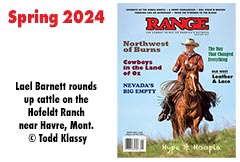

 |
 |
|
Ridin' Shotgun Likker. By Jeff Goodson
When I was just a little shaver, I spent summers on a cow-calf operation in deep east Texas. The place was in the piney woods, on the banks of the Attoyac, not far from the Sabine River and the Louisiana border. You could drive a thousand miles from there to the Atlantic with only minor variations in the landscape÷pine and mixed hardwoods blanketing the hills, shallow tannin creeks and deep muddy rivers, barbecue shacks and small town drive-ins. These are places famous for the ones who made them famous, not for how they looked. This particular little corner of heaven had been the stomping grounds of Bonnie and Clyde back in the â30s, but thatâs a different story. The summers were hard work and high recreation. I mostly pulled hay-baling duty. Then, we used square balers and wire, and every now and then youâd reach down to throw up a bale on the flatbed and find out it weighed 70 instead of 40 pounds. Or, worse, that it had baled up a live cottonmouth. The pay was good though at 10 cents a bale÷loaded, hauled and stacked in the barn; the company was fine; and the cold beer, especially on a blistering Texas July day, was positively salivating. Now being a whole lot of years underage, even for the time and the place, I wasnât exactly a connoisseur of the fine art of brewmaking. Fact is, about the most beer I had ever tasted before my hay-baling days was a slurp on the sly from the old manâs can when he wasnât looking. But that was irrelevant, since you couldnât buy beer there anyway. Being full of God-fearing people, this county÷like most counties in east Texas÷was dry. Thatâs ădry,ä as in no alcoholic beverages bought or sold, or, even better, ădrah,ä which is how we pronounced it and how your gullet felt from lip to gizzard after throwing hay in 105-degree heat. But the folks thereabouts were nothing if not creative. Not so much in an artistic sense you understand, although I like reproduction cowboy art as much as the next fellow. No, they were creative in life stuff. And one of the life-stuff things they happened to be most creative at was making home brew. There were all kinds of recipes for home brew back then, and I wouldnât have presumed to hold forth authoritatively on the various pros and cons of the brewerâs art÷at least not with older folks around. But like all art, I did know what I liked. And my tastes in those halcyon days tended towards a conservative little mixture of the local iron-tainted groundwater, a five-pound bag of Imperial cane sugar, a large can of Blue Ribbon malt syrup with hops, and a couple of packets of Fleishmannâs yeast. Delicately stirred together in an eight-gallon crock, and covered with cheesecloth to keep out the critters, this concoction was then placed outside in the shade and allowed, as we called it, to ăwork.ä
After a couple of days of working, the nectar would commence to foaminâ and churninâ. We would taste it periodically, to make sure it hadnât gone too far and turned into something stronger than God intended for gentle souls such as our own selves. Once it hit just the right potency, we would ăbottleä it in plastic Clorox jugs, ice it down in the cooler, and head for the low pasture. Even though our home brew had a little kick to it, that didnât interfere with the hay baling. You could guzzle a lot of it on a hot day and never even break into song. What it did do was slake the thirst in a way that regular water, or regular whiskey for that matter, never could do. That county is still dry, 40 years later, but the days of making home brew have gone the way of Bonnie and Clyde. In the early â60s, a local named Hack started up a package store on the wet side of the Attoyac in Shelby County. The beer was several notches above our best, although it lacked the residual fragrance of Clorox that I always thought added a distinctive flavor. Hackâs was, to boot, a never-ending source of amusement, camaraderie and stories, although occasionally on a Saturday night someone would catch a bullet there over some variety of love dispute. A few months ago, my brother and I were up in that neck of the woods to see the family, and we just happened to find ourselves in the immediate neighborhood of Hackâs. We pulled in to make a small purchase÷just for old times sake, you understand. Except for the girl behind the counter, nothing much had changed. The parking lot still consisted of red clay and cigarette butts, the door still creaked on its hand-nailed hinges, and the wood-plank floor was layered with half a century of blood and spit. No, Hackâs still hadnât made it into the pages of Architectural Digest, but on this day in the late east Texas afternoon, the beer was cold, I was with family, we were at home. All was right with the world.
BIO Jeff Goodson is president of JW Goodson Associates, Inc., a property consulting company, and a regular contributor to RANGE. |
|